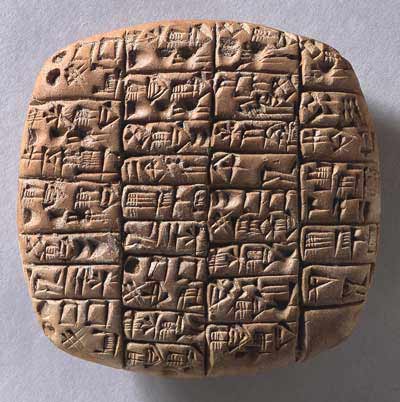How Writing Changed the World

Each Monday, this column turns a page in history to explore the discoveries, events and people that continue to affect the history being made today.
Humans had been speaking for a couple hundred thousand years before they got the inspiration or nerve to mark their ideas down for posterity.
But when a Mesopotamian people called the Sumerians finally did scratch out a few bookkeeping symbols on clay tablets 5,000 years ago, they unknowingly started a whole new era in history we call, well … history.
The presence of written sources denotes the technical dividing line between what scholars classify as prehistory versus what they call history, which starts at different times depending on what part of the world you're studying.
In most places, writing started about the same time ancient civilizations emerged from hunter-gatherer communities, probably as a way to keep track of the new concept of "property," such as animals, grain supplies or land.
By 3000 B.C. in Mesopotamia (present-day Iraq), and then soon after in Egypt, and by 1500 B.C. in China, people were scribbling, sketching and telling their world about their culture in a very permanent way.
When memory failed
Sign up for the Live Science daily newsletter now
Get the world’s most fascinating discoveries delivered straight to your inbox.
When ancient Mesopotamians started settling down onto farms surrounding the first cities, life became a bit more complicated. Agriculture required expertise and detailed recordkeeping, two elements that led directly to the invention of writing, historians say.
The first examples of writing were pictograms used by temple officials to keep track of the inflows and outflows of the city's grain and animal stores which, in the bigger Sumerian urban centers such as Ur, were big enough to make counting by memory unreliable.
Officials began using standardized symbols — rather than, say, an actual picture of a goat — to represent commodities, scratched into soft clay tablets with a pointed reed that had been cut into a wedge shape. Archaeologists call this first writing "cuneiform," from the Latin "cuneus," meaning wedge.
The system developed quickly to incorporate signs that represented sounds, and soon all of Mesopotamia was taking notes, making to-do lists and (presumably) writing love letters.
Egyptian writing — the famous hieroglyphics — developed independently not long thereafter, under similar circumstances, historians think.
A few thousand years later, as variations on the two systems spread throughout the region, the entire ancient world had writing schemes that vastly improved the efficiency of economies, the accountability of governments and, maybe most importantly to us, our understanding of the past.
Literacy a privilege
Reading and writing in ancient times wasn't for the masses, however. Daily life in Mesopotamia and Egypt was time-consuming, and so writing became a specialized profession, usually for members of the elite class. The highly-regarded scribes of ancient Mesopotamia were even depicted in art wearing cuneiform writing implements (a bit like a set of chopsticks) in their belts as a mark of their importance.
Literacy remained a privilege of aristocratic males in most societies all the way until the 19th-century, when public education became more widespread around the world.
That means that while the historical period is exponentially better understood than the experiences of humans before writing was invented, written accounts are largely about the experiences of the upper classes, historians say.
About one in five people today, concentrated mostly in Third World nations, are illiterate.
- Last Week: How the Hyoid Bone Changed the World
- Next Week: How Ancient Trade Changed the World
- Top 10 Ancient Capitals
- World Trivia
Why is yawning contagious?
Scientific consensus shows race is a human invention, not biological reality











